| Detective
Deleuze Stephen O'Connell |
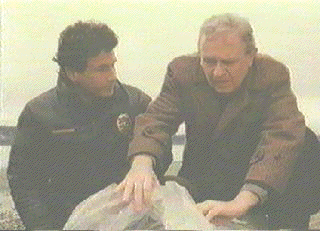 |
| Detective
Deleuze Stephen O'Connell |
 |
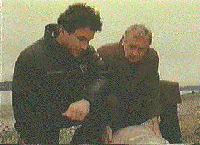 |
Twin Peaks 1 is a television detective serial that revolves around the question of who killed Laura Palmer, a small town American sweet heart. For two seasons the show followed an FBI agent as he unravelled a seemingly endless web of connections between this dead prom queen and the shady underworld of a north-west logging community. Rather than proceeding along a logical path of clues to the murderer, the FBI agent Dale Cooper, becomes more and more intwined in the world that he interprets. The murderer, known as Killer Bob, has a puzzling proximity. He lurks in the shadows of this film noir town, but he also occupies the unmarked roads and abandoned cabins of the unconscious. For most of the series Agent Cooper doesn't really try to clarify the contours of good and evil in Twin Peaks, instead he demonstrates how to live in such a complicated world. When the show is cancelled a killer is finally revealled under a certain amount of contractual obligation, but by this stage the case of Laura Palmer has posed too many problems to be resolved by a single arrest. The creators, David Lynch and Mark Frost have produced a world where the interpretation of signs is an ongoing project that makes things move, change, or to use a Deleuzo-Guattarian term, "become". |
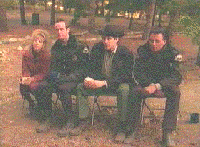
|
Strictly speaking, Twin Peaks can not be soley attributed to Lynch and Frost. During the second season a variety of film makers were invited to try their hand at the Twin Peaks formula. And the show generated publications such as Laura Palmer's Diary and a travel guide to the imaginary town, which offered different author's perspectives on Twin Peaks. To blur boundaries further Twin Peaks not only extends itself through different authors but it invents new roles for Lynch and Frost. On American television Lynch and Frost produced their own commercial breaks, using actors from the cast. When the series was cancelled they made a feature length prequel based on the days leading up to Laura's murder. And Lynch not only produces, writes, and directs various episodes, but he acts the part of Agent Cooper's FBI mentor, who occassionally totters into Twin Peaks offering advice. But attributing specific contributions doesn't really help us understanding how this dynamic called Twin Peaks works. The Lynch-Frost assemblage outlines a plane of consistency, a vibrating plateau of matter, across which meaning is developed through unpredictible encounters. And this is the rub, I mean this is why Twin Peaks interests me in the context of my larger interest in the methodological implications of Gilles Deleuze's work for writers in the visual arts. Twin Peaks is a world very much like our own, where interpretation has no stable basis; a world where the credibility of underlying psycho-analytic, sociological, or linguistic structures has rapidly waned. The meaning of Twin Peaks the television series, and Twin Peaks the murder mystery, can't be reduced to such a priori structures, but conversly, it involves more than the romantic freeplay of meaning unfolded in a show like Northern Exposure. There is a certain weight in the movements of the opening sequence, which creates a sense of necessity within the chaos of this world. Following Deleuze and Guattari, I want to call this composition of meaning a "plane of consistency." |
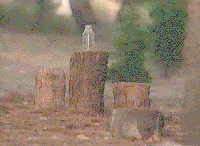
|
Twin Peaks begins with a question:
`whatever could have happened to give us this?' Deleuze
and Guattari claim that this fundamental relation to
secrecy characterizes the novella as a literary genre.
The novella "enacts postures of the body and mind
that are like folds or envelopments . . . states of the
body when it is surprised by something that just
happened. 2 In the
opening scenes of Twin Peaks we are given a
series of postures acted on by something imperceptible. A
girl runs across the school yard screaming, a mother
cries, unknown characters tremble with fear. Intense
close-up shots of faces, phones, and rotating fans
reverberate with the secrets which are folded up in their
postures. The present moment appears with a suspended
kind of significance. The past has a indiscernible
immediacy.3 We've seen this element of suspended surprise in Lynch's work before, particularly in early films such as The Grandmother (1970) and Eraserhead (1977). The vomiting torsos and decomposing figures in Lynch's paintings and installation works similarly pose a question to the past: Something harrowing has happened, but what? Mark Frost on the other hand, is known for writing television scripts such as Hill Street Blues. A television serial is more like a tale than a novella, because it is excited by the future. Hill Street Blues is exemplary in this respect. From the hectic morning briefing at the beginning of each episode, the actors move rapidly through a series of attitudes and positions to a point of fatigue or frustration at the end of the day. Every day in the police force is a new day of discovery. Deleuze and Guattari explain that this type of "tale is the opposite of the novella, because it is an altogether different question that the reader asks with bated breath: What is going to happen?" 4 These two aspects of time - the secrecy of the past in Lynch and the encounter with the future in Frost - are brought together in Twin Peaks. We can call this a plane of consistency; a dynamic mode of composition which holds together divergent forces in a zone of intensity or multiplicity. |
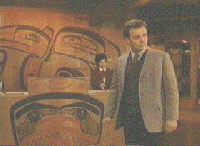
|
When Deleuze writes about these vibrating planes of
consistency, he is not simply opposing the multiple to
the One, or the chaotic to the linear. Deleuzean
multiplicities have their own principles of organization,
which prevent them from being recuperated by a
dialaectical exchange between the multiple and the One.
This is evident in the way that Deleuze and Guattari
zig-zag their theory of literary time between the
novella, the (detective) novel, and the tale. Together
they constitute a "determinable multiplicity"
which is not ordered from above, but organized from
within. Different signs express these vectors of time
from different perspectives, and consequently create new
lines and tangents of duration. The field of forces
defined by this particular constellation seems to be
derived from Nietzsche's model of the dice throw; an
important point of reference in Deleuze's theory of time.
In Nietzsche's Thus Spake Zarathustra, the metaphor of the dice throw is used to construct an alternative to dialectical progression. Deleuze explains that there are two moments in the game of dice: the moment when the dice are thrown (on the earth's table of immanence), and the moment when they fall back in a certain combination (on the transcendent table of the sky). 5 The first moment, which is highlighted in the tale genre, refuses control and order by affirming the chance of future encounters. As we throw the dice or follow the tale, we don't look elsewhere for difference to be determined, we expect differences to arise internally, from the immanent field of possibilities. In Nietzschean terms this is the "being of becoming"; pure multiplicity. In the second moment, something is performed within the chaotic world unravelled by the throw. The dice fall back, or a posture is enacted, uniting all the fragments of chance in a single moment. A coherent whole is formed, which affirms the neccesity of specific being, but because it is founded in chance this second moment cannot refer an a priori structure or order that might maintain it. Like the suspended postures of the novella, this second moment expresses the turbulent immediacy of a previous moment. Nietzsche says that it is the return of the first moment. Or as Michael Hardt explains, "the two moments imply one another as a perpetual series of shattering and gathering, as a centrifugal moment and a centripetal moment, as emanation and constitution." 6 |
 |
In the passage from A Thousand Plateaus
where Deleuze and Guattari discuss literary genres, the
detective novel is actually described as a genre which
tends to seperates these two moments and order them into
a teleological progression. The single moment in question
for the detective, has already happened and remains to be
discovered. In terms of the dice throw, the detective
relies on a large number of throws before he obtains the
`truth' of this past event. This is essentially a warning
by D&G not to separate the past, present, and future
into discrete periods, and to always be concerned with
their necessary complicity, even when one dimension
dominates. The creators of Twin Peaks
understand this complication, and know how to accept
every fall of the dice. The series begins with the second
moment of specific being, but this already appears within
the chaotic unfolding of the television series. Lynch and
Frost twist the detective genre, so that it tenders an
ambiguous, two-fold relation with time, which is
necessary for movement through multiplicities. When the postures in the opening scenes of Twin Peaks, folded and moulded by something imperceptible, begin to unfold it becomes clear that Lynch and Frost are not interested in an answer. The unfolding does not explain the postures as much as it complicates them in a dice game which combines characters, serialises subjectivity, and extracts meaning from the internal and ever changing resonnances distributing the plane of consistency. When the crying faces of Laura's mother and the policeman photographing Laura's body fall back it seems that they must have both been very close to the dead girl, but despite having the same combination on their faces, the similarity of their postures lies in difference. The policeman is a softy who can't help crying when he has to deal with something tragic, and the mother's hysteria is so excessive, eventually manifesting itself in visions, that she seems to be effected by something even she does not understand. The different moments of the series are not linked together in a logical way, rather, the unfolding of attitudes and positions concealed in the postures is a complication and diversification of being. Each stage of unfolding is a repetition of the internal difference involved in the present moment. As Howard Hampton has observed, the postures of Twin Peaks "begin a dialogue among themselves" which work against any linear reading of the storyline. 7 The concept of becoming that we find in Twin Peaks plays havoc with common-sense notions of time to the point where the episodes can be enjoyed out of sequence, and a prequel can still keep people interested even though Laura's murderer has been revealed. |
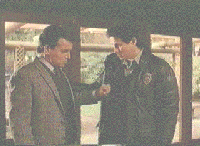
|
This play of sameness and difference is produced by
the eternal repetition of difference in every posture.
The posture of a body, which is the moment of being, is
always returning as another synthesis of the flow of
chance which unfolds around it. The dice player who
accepts every throw brings the two moments together in a
whole which has no opposites, no limitable other, but
which is always open ended and dynamic. This is the
non-dialectical synthesis which Nietzsche called the
eternal return; the eternal return of the same as
different. Later in the first series, Agent Cooper persuades the local law inforcement team to set up a rather wacky Ouija-board-cum-game-of-chance, designed to help direct the investigation. After taking them into the forest and giving them a short speech on the Dali Lama, he assigns each of them a role in harnessing the forces of his perculiar game of chance. The sheriff calls out the names of suspects, one deputy holds a pail of rocks which Cooper methodically throws at a bottle carefully set up some distance away by another deputy, and the secretary takes cryptic notes on a blackboard. Like the viewer, Agent Cooper is trying to make his way through this web of complications. Each clue to the murder and each posture of a suspect is in excess of itself, sticky with the complications and connections of multiplicity. As the interpreter of signs, Cooper never ceases making connections, linking up semiotic chains, bringing new dimensions of time - dream time, historical time, baseball time - into play. Cooper accepts the violence of signs. He is affected by the encounter. In the Tibetan forest scene, for instance, the letter `J' and a disjointed dream affect his body in such a way that its cognitive faculties are redistributed to create a body with an open assemblage of organs; a body set free from the organism. the police force turns into a giant brain, relaying its thoughts back and forth between a bucket, a milk bottle, and a blackboard. Along with Zarathustra, Agent Cooper might exclaim: "in an instant I shall be nothingness . . . the complex of causes in which I am entangled will recur - it will create me again! I myself am part of these causes of the eternal recurrence."8 If both the subject of the investigation and the signs being interpreted are produced within this radical becoming, then the meaning of signs can not be derived from a preexisting linguistic structure, nor can the investigator assume a critical distance from the world which entangles and creates him. In these conditions the subject becomes an image or a screen, a sign amoung other signs. Expressing a turbulent universe in the specificity of his or her being. Synthesising divergent series in the repetition of his or her postures. Felix Guattari might describe this type of subject as the "true art work", that is, "the infinite body . . . moving through all the incredible mutations of any one life time."9 It is this post-human aestheticism which Twin Peaks tenders so well; the body as an art work, truth as a continually reconstituted fiction. Nietzsche applauds art for precisely this ability to magnify falsehood, to raise a world of pure appearance and error. "What is required", Nietzsche explains, "is to stop courageously at the surface, the fold, the skin, to adore appearance, to believe in forms, tones, words . . . to be superficial out of profundity."10 This type of modal existence displaces all fixed notions of identity to make room for a rich system of creative intensities. It is when we reach this threshold of surface tensions, learn to work with affected faculties, and begin operating by contracting and dilating the movement of the images we encounter, that we might grasp what Deleuze means when he says: "My ideal, when I write about an artist, would be to write nothing that could cause him sadness, or if he is dead, that might make him weep in his grave. Think of the artist you are writing about. Think of him so hard that he can no longer be an object, and equally so that you can not identify with him. Avoid the double shame of the scholar and the familiar. Give back to an artist a little of the joy, the energy, the life of love and politics that he knew how to invent."11 Stephen O'Connell Endnotes
|